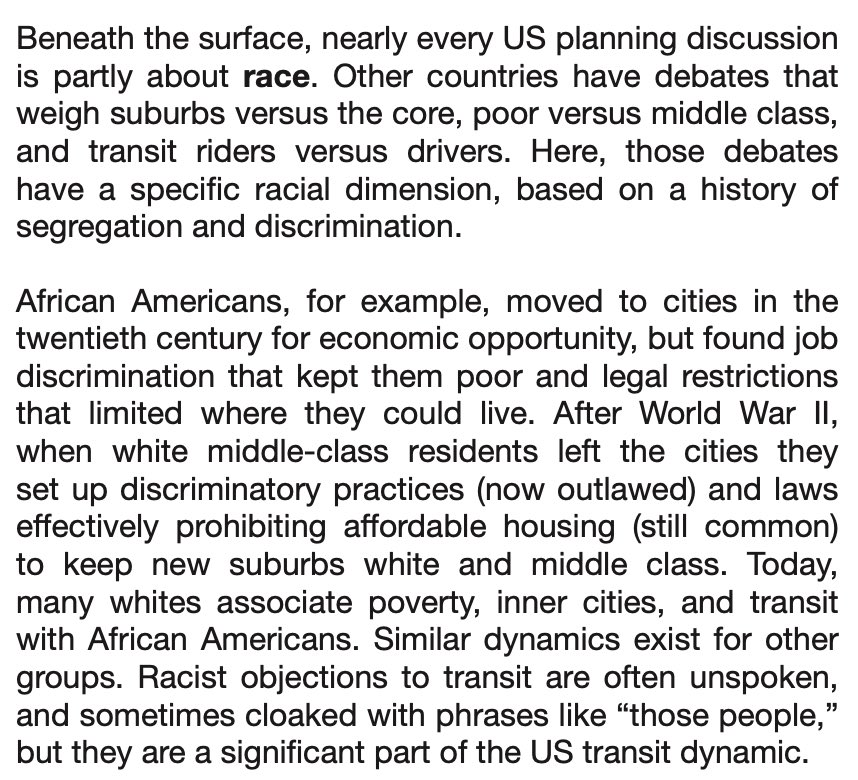As we talk transportation, urbanism, cities, and racism, Transit agencies, and the transit industry, should not assume we are the good guys, or, as @Jay_Pitter put it, “bringers of solution.”
I’m not singling out transit here. It has not been nearly as destructive an implement of racism as the construction of the US freeway system, and today transit agencies tend to be much more thoughtful about their impacts on people of color than highway agencies.
But race is always there in transit discussions (here& #39;s what I said about that in Trains, Buses, People.) And whether we talk about it or not (we usually don’t), it& #39;s often the direct or indirect motivation behind transit decisions.
I think that much of how we think about transit in the United States today comes from how transit agencies were created in the 60s, 70s and 80s. Transit agencies are shaped by the world they were created in — the era of the re-segregationist response to the civil rights movement.
Perceptions at the time: “Urban" mean black, “Suburban" meant white. Urban areas were declining, suburbs were booming. Urban areas seemed dangerous; surburbs seemed safe. Urban areas needed government support/“bailouts”/“welfare”; suburban areas needed infrastructure for growth.
Most existing transit systems were urban and carried a relatively low income and disproportionately Black ridership. Transit, which pre-WWII had been for everyone, was now largely perceived as a mode for poor people in big cities. (All this, of course, is still familiar today.)
Transit agencies were created as a response to two different problems: existing transit operations were going bankrupt (risking stranding the urban Black riders), and highway congestion was increasing (requiring new options for suburban white car commuters.)
That dual mandate never really got reconciled in the world of transit, and it still shapes the transit we operate today. It’s often expressed in terms of “dependent" and “choice" riders -- terms which sound neutral (even thoughtful) but lead to policy with racist impacts.
For the "dependent riders," transit agencies preserved and somewhat expanded urban bus (and sometimes rail) systems. But the "dependent” weren’t going to be picky -- the primary emphasis here was on providing service, not providing a good experience.
For the “choice riders," agencies need to provide great service -- shiny new rail lines, limited stop express commuter buses -- which was fast, reliable, comfortable, safe.
As a result of this dual mandate, many agencies essentially built and operated two systems - different standards for amenities, different service levels, different levels of subsidy. This isn& #39;t a bus/rail divide, though it often plays out that way. This is intent, not technology.
What it is a transit planning and operations strategy built around the idea that there are two kinds of riders, one (assumed to be white) who need (and deserve) great service because they have a choice, and one (largely Black) who don’t need anything beyond the bare minimum.
That shows up obviously in how we fund and build transit. Look at the typical US bus stop, at the plush seats on suburban buses and plastic seats on urban ones, at the subsidy for commuter rail compared to bus, at the condition of P&R lots compared to sidewalks -- you see racism.
But it goes beyond that, transit agencies concluded that to attract "choice riders” they needed to design for (as @DrDesThePlanner incisively puts it) “white comfort." Those choice riders come to board meetings and talk about wanting to feel safe.
Choice riders don’t want to be around vagrants or people who seem "sketchy." (And we all know what that can be code for.) Choice riders live in places where they and their neighbors are concerned about criminals coming in from the city.
So agencies deliberately keep the two systems separate. Why do many systems have higher fares for commuter rail/commuter bus? Why do rail systems built to serve the suburbs bypass dense urban neighborhoods? Why do suburban and urban buses stop on different downtown streets?
Transit systems have racism built into their schedules, their fleets, their route structures, and their infrastructure. And I haven’t even mentioned transit police, and fare enforcement…
(Also, more recently, some agencies have added a third major goal -- real estate development. Done well, this is great -- more homes, jobs, services near transit = transit is more useful. But we have a long history of development that& #39;s designed to displace Black communities.)
Of course, many agencies also have racism built into their governing structure. Why do suburban areas often have separate agencies from their big cities? There are legitimate reasons for this, but it seems to happen a lot where cities are heavily Black and suburbs very white.
Transit agencies absolutely can be powerful tools for equity. A good transit network opens up a metropolitan area -- and its jobs and opportunities -- for everyone.
But we in the transit world have to be thoughtful about what we do. We need to ask what we’re doing that perpetuates structural racism.
Internally, that means not accepting "we& #39;ve always done it that way" as an answer because we know that what we did in the past was part of racist systems. Why does every rail station get a shelter and not every bus stop? “That’s the standard” is not an answer.
It means being willing to call out decision makers. It means being willing to call out partners -- the city that bus stop is in is part of the problem. It means listening to all riders and all communities. It means boards that actually reflect the diversity of riders and cities.
It means affirmatively trying to be part of the solution, not just doing what& #39;s comfortable + congratulating ourselves for how equitable we are. It means we all have to be willing to talk about this stuff - we can’t leave it to people of color or the "equity person" to speak up.

 Read on Twitter
Read on Twitter


